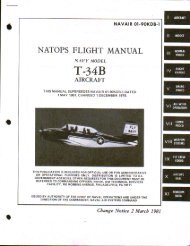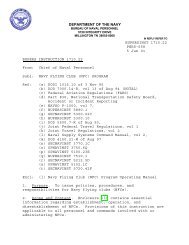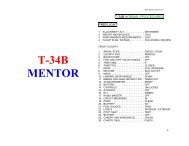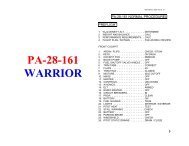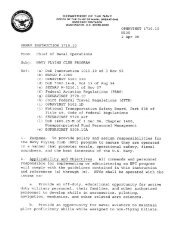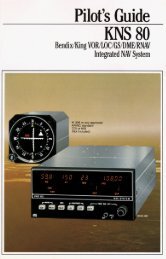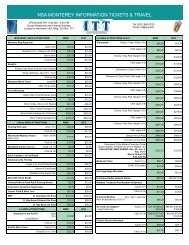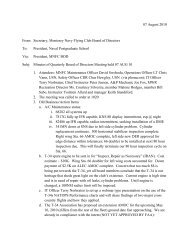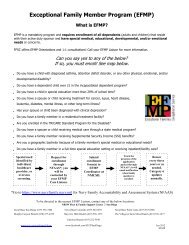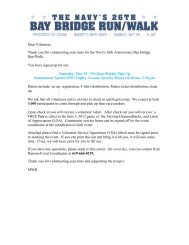KX 155 and KX 165 - NavyLifeSW.com
KX 155 and KX 165 - NavyLifeSW.com
KX 155 and KX 165 - NavyLifeSW.com
You also want an ePaper? Increase the reach of your titles
YUMPU automatically turns print PDFs into web optimized ePapers that Google loves.
Innovative‘‘flip-flop’’digital displays bring you push<br />
button frequency preselection for both NAV <strong>and</strong> COMM.<br />
Photocell<br />
for automatic<br />
dimming of<br />
all readouts.<br />
It always pays to plan ahead. And<br />
with the Bendix/King <strong>KX</strong> <strong>155</strong> <strong>and</strong><br />
<strong>KX</strong> <strong>165</strong> NAV/COMMs, “stay ahead”<br />
frequency pre-planning is push button<br />
simple.<br />
Both NAV <strong>and</strong> COMM frequency<br />
displays on these units incorporate<br />
the popular “flip-flop” preselect feature.<br />
So, you can set up en route or<br />
approach frequency changeovers well<br />
in advance of your actual transition<br />
point or ATC h<strong>and</strong>off sequence for<br />
true “stay ahead” flight management.<br />
Just select your up<strong>com</strong>ing NAV<br />
or COMM frequency in the “st<strong>and</strong>by”<br />
(STBY) display, <strong>and</strong> you’re all set to<br />
“flip-flop” it into “active” status at the<br />
press of a button. This function may<br />
also be controlled from an optional<br />
remote mounted switch.<br />
Both “active” <strong>and</strong> “st<strong>and</strong>by” frequencies<br />
are displayed simultaneous-<br />
ON/OFF/VOL<br />
Control switch<br />
(Pull out<br />
for TEST;<br />
push in<br />
for automatic<br />
squelch.<br />
COMM frequency<br />
transfer button<br />
ly, so you never have to worry about<br />
what’s being stored. And there’s<br />
no chance of inadvertently erasing<br />
a frequency just when you need<br />
it most.<br />
An innovative non-volative memory<br />
circuit holds all the displayed frequencies<br />
in storage—through aircraft<br />
shutdowns or momentary power<br />
interruptions—without the need for<br />
battery power of any kind.<br />
Large, self-dimming, microprocessor-controlled<br />
gas discharge readouts<br />
<strong>and</strong> solid-state electronic tuning<br />
provide fast, accurate selection of all<br />
200 NAV <strong>and</strong> 760 COMM frequencies —<br />
<strong>and</strong> both the <strong>KX</strong> <strong>155</strong> <strong>and</strong> <strong>KX</strong> <strong>165</strong> feature<br />
a built-in 40-channel glideslope<br />
receiver. (As an option, they’re also<br />
available without the glideslope.)<br />
On the COMM side, both the<br />
<strong>KX</strong> <strong>155</strong> <strong>and</strong> <strong>KX</strong> <strong>165</strong> systems give you<br />
COMM frequency<br />
selector knobs<br />
“T” indicates mike button<br />
is being depressed when lighted<br />
7-segment gas discharge numerics<br />
On the <strong>KX</strong> <strong>165</strong> model, a digital readout of the<br />
radial you’re on (from the “active” VOR station)<br />
is displayed in the “st<strong>and</strong>by” NAV frequency<br />
window whenever the smaller NAV frequency<br />
selector knob is pulled out.<br />
VOL/IDENT<br />
switch<br />
(Pull out<br />
for ident tone)<br />
10 watts minimum transmitter power<br />
for maximum range <strong>and</strong> clarity.<br />
And on the NAV side, the <strong>KX</strong> <strong>165</strong>’s<br />
useful “Radial” feature offers you<br />
an instant readout of the radial<br />
you’re on (from the “active” VORTAC<br />
station), digitally displayed in the<br />
“st<strong>and</strong>by” NAV frequency window.<br />
This Radial readout doesn’t interfere<br />
with either your “active” or “st<strong>and</strong>by”<br />
NAV frequencies. (However, the NAV<br />
“st<strong>and</strong>by” frequency does go into nondisplayed<br />
storage, <strong>and</strong> the “active”<br />
frequency then be<strong>com</strong>es linked for<br />
direct tuning through the frequency<br />
selector knobs.) Thus, with both<br />
“active” <strong>and</strong> “st<strong>and</strong>by” frequencies<br />
continuously available, it’s easy to<br />
perform a quick crossfix check by<br />
simply pressing the “flip-flop” button<br />
<strong>and</strong> noting the displayed radial from<br />
each of the two selected VORTACs.<br />
NAV frequency<br />
transfer button<br />
NAV frequency<br />
selector knobs<br />
(see below for<br />
<strong>KX</strong> <strong>165</strong> model.)



